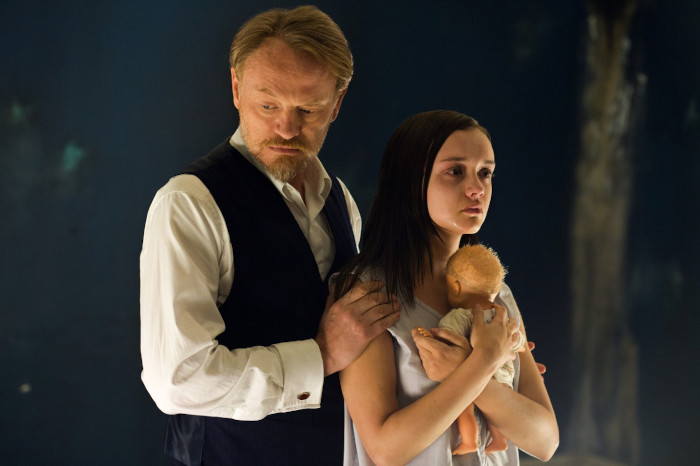Released between the two The Woman in Black films, The Quiet Ones has some very good performances to its name (especially from Olivia Cooke and Jared Harris) but the story is a damp squib and while director James Pogue (writer of Rollerball (2002), Ghost Ship (2002) and Quarantine 2: Terminal (2011), the latter of which he also directed) pulls off a few solid jump scares, the film remains stubbornly atmosphere-free.
The script, by Pogue, Tom de Ville, Craig Rosenberg and Oren Moverman, takes inspiration from the real-life Philip experiment conducted by a group of amateur parapsychologists in Toronto in 1972, in which a fictional character named “Philip Aylesford” was created by the group who then tried to communicate with it via a séance through the expectations they had created for themselves. The theory was that ghosts were just projections of the human subconscious but their work was both inconclusive and widely panned by their peers over matters of methodology.

In the film, it’s 1974 and Oxford student Brian McNeil (Sam Claflin) is asked to bring his movie camera and sound recording equipment to an isolated country house where controversial lecturer Professor Joseph Coupland (Jared Harris) has set up camp to further his experiments. Coupland believes that the supernatural is all bunk and to prove it has brought the deeply troubled Jane Harper (Olivia Cooke) to the house. An orphan, she’s spent her life being shunted from one foster family to another as weird, inexplicable happenings seem to follow her. Coupland has also invited along two more of his students, Krissi (Erin Richards) and Harry (Rory Fleck-Byrne). It soon becomes clear that Coupland is less than entirely mentally well balanced himself and as he subjects Jane to sleep deprivation, stages séances uses extreme hypnosis events in the house soon spiral out of control. Despite Coupland’s beliefs, Jane really can manifest supernatural forces that are soon picking off the ground one-by-one.
We know that we’re in the 1970s immediately because the first thing we hear is Slade’s 1973 hit Cum on Feel the Noize at deafening volumes (it turns up again later as the main component of those sleep deprivation experiments) and because almost everyone smokes like a chimney. It’s the sort of last shortcutting that epitomises the laziness of the film – Pogue tosses in a dash of “found footage” but otherwise this is another disappointingly mundane and wholly undistinguished film from Hammer who were still finding it impossible to establish anything like a house style or even a sustainable level of consistency.

Pogue is an efficient but unremarkable director who has to fall back on that bug bear of the contemporary supernatural horror film, the propensity for loud bangs and crashes on the soundtrack (the film is very poorly named) in lieu of atmosphere or actual scares. The cast is the best thing about the film and they’re a game bunch, sporting unflattering 70s fashions as if born to them but despite all their best efforts they are ultimately defeated by the dull dialogue and unengaging storyline. Cooke manages to bring an under-written character to life to a degree that one suspects wasn’t in the script itself and Harris is excellent as the manipulative and controlling Coupland. The rest of the small cast are mostly decent enough, but their characters are given so little personality that even more experienced performers would have struggled to do anything better with them.
The extraordinary post-Millennial boom in horror films had given rise to a whole strain of similar supernatural horror film – loud, unoriginal, with ghosts and other supernatural entities that glower and screech and which have very little new to add to a very over-crowded field. This makes it particularly hard for filmmakers to cut anything original from the threadbare cloth and The Quiet Ones is simply not original enough to cut through the noise. It’s a so-so film, not awful (God knows, Amazon Prime is littered with supernatural horror films far worse than The Quiet Ones) but it’s not particularly memorable in any way. Films like this were ten-a-penny and apart from those decent performances, it doesn’t have much to set it apart from the pack.

If the new owners of Hammer were serious about reviving the venerated name and keeping it relevant and in business, they really needed to find a story more original to tell than this one. They also needed to be bolder in their choices – The Quiet Ones feels like a ploy to mine the same territory already explored in The Woman in Black (2012), with its old dark house and supernatural presences. It needed something further off the beaten track and although their next film, The Lodge, had some problems it was at least a step in a more interesting direction. Incidentally, if the house where the horror unfolds seems familiar, you’ve been paying attention to your Jose Larraz films from the 1970s. It’s Harefield Grove where the Spanish director shot parts of Symptoms (1974) and Vampyres (1974). It can also be seen in the BBC’s 2015 version of And Then There Were None.